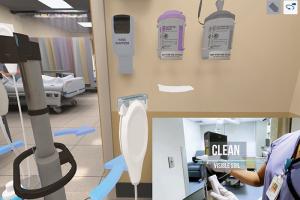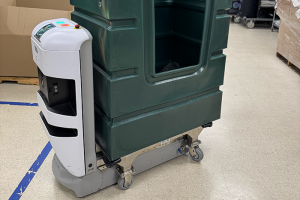HAI transmission in the health care environment
Disinfection of the patient environment is a key component of the infection prevention and control process. One of the most critical interventions that can be performed to decrease the risk for cross-transmission and development of health care-associated infection (HAI) is routine cleaning and disinfection of the health care environment. This includes both medical equipment and environmental surfaces.
Environmental surface disinfection is an important factor in the prevention of HAIs. The many environmental surfaces in health care settings are considered noncritical surfaces and, therefore, require a low-level disinfectant. Cross-contamination can occur in a variety of ways, but most often the environmental surface becomes contaminated and then serves as a reservoir for microbial growth. The hands of either the provider or the patient come in contact with this surface, and then contact is made with another device or surface, thereby contaminating it.
The ability of microorganisms to successfully survive and reproduce on environmental surfaces has never been greater. Organisms such as methicillin-resistant Staphylococcus aureus, Escherichia coli, Clostridium difficile and Mycobacterium tuberculosis can survive on surfaces for several months. Because of the resilience of these microorganisms, it is important to routinely disinfect potentially contaminated surfaces to reduce the risk of transmission.
Before effective disinfection can occur, it is important to thoroughly clean visibly soiled environmental surfaces to allow for the full efficacy of the disinfectant. Cleaning as defined by the latest Centers for Disease Control and Prevention (CDC) Guideline for Disinfection and Sterilization in Healthcare Facilities released in 2008 is the removal of foreign material (e.g., soil and organic matter) from objects, and normally is accomplished using water with detergents or enzymatic products.
Thorough cleaning prior to high-level disinfection and sterilization is important because inorganic and organic materials that remain on the surfaces of instruments interfere with the effectiveness of these processes. Cleaning removes bioburden from the affected surface by reducing the number of microorganisms that must be inactivated, according to the CDC guideline. Removing bioburden from the surface prior to application of the disinfectant solution will result in increased disinfectant efficacy. It is important to also apply friction to the area being cleaned and disinfected to remove more resistant forms of microorganisms such as spores from the surfaces that may not be readily inactivated by the disinfectant. This will decrease the risk of developing multidrug-resistant organisms.
Such high-touch surfaces as blood pressure cuffs, stethoscopes and glucometers require frequent disinfection to prevent cross-transmission between patients. The physical number of microorganisms present on any given surface is influenced by a number of factors, including the amount of moisture on the surface, the amount of activity taking place in the immediate environment, the number of people having contact with the environment, and the type of environmental surfaces and their ability to support the growth of microorganisms.
For more information on disinfection and sterilization, visit the AHE website at www.ahe.org.
By J. Hudson Garrett Jr., Ph.D., vice president of clinical affairs, PDI Inc., Orangeburg, N.Y., and chairman of the AHE research committee.
Valuable resources available
AHE represents, defines and advances the professionals responsible for care of the health care environment to ensure high-quality outcomes and healthy communities. Here are a few of the resources that AHE offers.
• Recommended Practice Series: Environmental Services Equipment and Supplies. The equipment and supplies covered in this booklet are essential, discrete components of safe, efficient and productive environmental services (ES) operations. For more information, go to www.ahe.org/ahe/learn/tools_and_resources/publications.shtml.
• Benchmarks and other Metrics for Effective Linen Management. This webinar looks at metrics such as processing and replacement costs, pounds per adjusted patient day, total cost per pound and labor-distribution cost per pound to help you assess and evaluate the cost-effectiveness of your program. To access it, log on to www.ahe.org/education.
• AHE Environmental Sustainability Certificate Program. AHE has launched a new certificate program to acknowledge the ongoing and outstanding environmental and ecological sustainability efforts of ES departments. For more information on the program, go to www.ahe.org/ahe/lead/environmental_sustainability_certificate_program.shtml.



